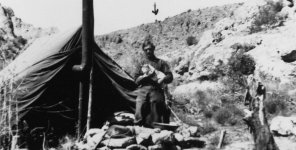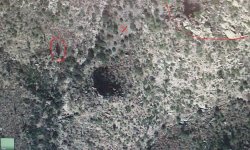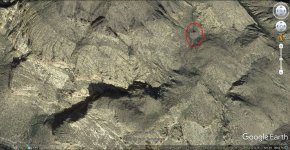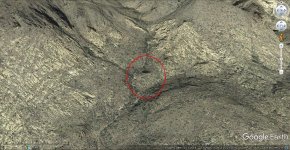skyhawk1251
Sr. Member
I've been rereading "The Bible on the Lost Dutchman Gold Mine and Jacob Waltz", by Helen Corbin, and I decided to do some more close scrutiny of Deering Canyon using Google Earth. I know from my own on-the-ground explorations of Mohave County, Arizona that what is seen on Google Earth does not closely approximate what is seen walking the trails, but Google Earth is a great tool for the armchair traveler. While doing some no-sweat research, I found something interesting in an upper portion of Deering Canyon.
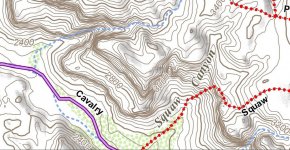
In the image above, the blue line marks a do-it-yourself trail through Deering Canyon. The strange feature I see in the upper canyon is located where the contour lines begin to be spaced farther apart as elevation is gained. The feature appears as a dark spot on the ground. It is enclosed by an ellipse.
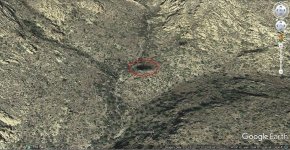
Below is a zoomed view of the same feature.
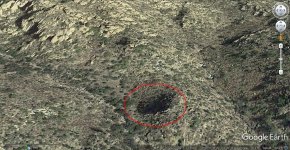
The ground appears to have subsided at this site, making a depression roughly circular in shape. The dark color of the depression seems to be mostly due to a solid carpet of vegetation, which could indicate that the ground was disturbed in the past. These aspects are essentially what would be expected if a large pit had been excavated, then filled-in. The landscape in the near vicinity of the depression is what fits the definition of a rincon -- a small, secluded valley.
This is a fascinating feature, and I'm not claiming that it is the pit mine that is described in the tales of the Lost Dutchman Gold Mine. I do know that people have walked past it, but not much information of any kind can be found that documents trips through Deering Canyon. If anyone has explored this general area, please share your observations.

In the image above, the blue line marks a do-it-yourself trail through Deering Canyon. The strange feature I see in the upper canyon is located where the contour lines begin to be spaced farther apart as elevation is gained. The feature appears as a dark spot on the ground. It is enclosed by an ellipse.

Below is a zoomed view of the same feature.

The ground appears to have subsided at this site, making a depression roughly circular in shape. The dark color of the depression seems to be mostly due to a solid carpet of vegetation, which could indicate that the ground was disturbed in the past. These aspects are essentially what would be expected if a large pit had been excavated, then filled-in. The landscape in the near vicinity of the depression is what fits the definition of a rincon -- a small, secluded valley.
This is a fascinating feature, and I'm not claiming that it is the pit mine that is described in the tales of the Lost Dutchman Gold Mine. I do know that people have walked past it, but not much information of any kind can be found that documents trips through Deering Canyon. If anyone has explored this general area, please share your observations.


